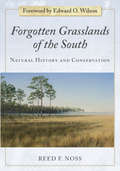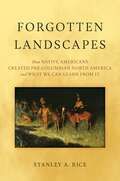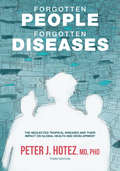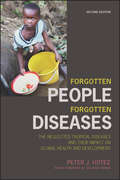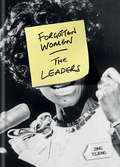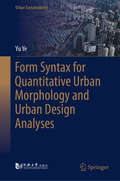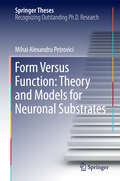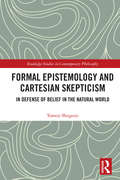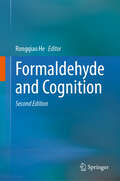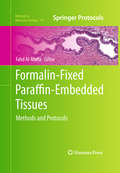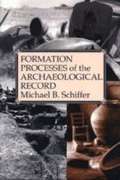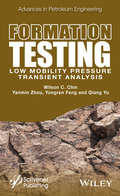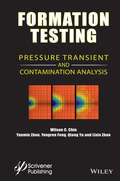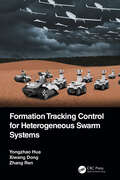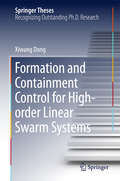- Table View
- List View
Forgotten Genius of Oliver Heaviside: A Maverick of Electrical Science
by Basil MahonFINALIST! 2019 IEEE William and Joyce Middleton Electrical Engineering History AwardThis biography of Oliver Heaviside profiles the life of an underappreciated genius and describes his many contributions to electrical science, which proved to be essential to the future of mass communications. Oliver Heaviside (1850 -1925) may not be a household name but he was one of the great pioneers of electrical science: his work led to huge advances in communications and became the bedrock of the subject of electrical engineering as it is taught and practiced today. His ideas and original accomplishments are now so much a part of everyday electrical science that they are simply taken for granted; almost nobody wonders how they came about and Heaviside's name has been lost from view.This book tells the complete story of this extraordinary though often unappreciated scientist. The author interweaves details of Heaviside's life and personality with clear explanations of his many important contributions to the field of electrical engineering. He describes a man with an irreverent sense of fun who cared nothing for social or mathematical conventions and lived a fiercely independent life. His achievements include creating the mathematical tools that were to prove essential to the proper understanding and use of electricity, finding a way to rid telephone lines of the distortion that had stifled progress, and showing that electrical power doesn't flow in a wire but in the space alongside it. At first his ideas were thought to be weird, even outrageous, and he had to battle long and hard to get them accepted. Yet by the end of his life he was awarded the first Faraday Medal. This engrossing story will restore long-overdue recognition to a scientist whose achievements in many ways were as crucial to our modern age as those of Edison's and Tesla's.
Forgotten Grasslands of the South: Natural History and Conservation
by Reed F NossForgotten Grasslands of the South is the study of one of the biologically richest and most endangered ecosystems in North America. In a seamless blend of science and personal observation, renowned ecologist Reed Noss explains the natural history of southern grasslands, their origin and history, and the physical determinants of grassland distribution, including ecology, soils, landform, and hydrology. In addition to offering fascinating new information about these little-studied ecosystems, Noss demonstrates how natural history is central to the practice of conservation. Although theory and experimentation have recently dominated the field of ecology, ecologists are coming to realize how these distinct approaches are not divergent but complementary, and that pursuing them together can bring greater knowledge and understanding of how the natural world works and how we can best conserve it. This long-awaited work sets a new standard for scientific literature and is essential reading for those who study and work to conserve the grasslands of the South as well as for everyone who is fascinated by the natural world.
Forgotten Healers: Women and the Pursuit of Health in Late Renaissance Italy (I Tatti studies in Italian Renaissance history)
by Sharon T. StrocchiaIn Renaissance Italy women from all walks of life played a central role in health care and the early development of medical science. Observing that the frontlines of care are often found in the household and other spaces thought of as female, Sharon Strocchia encourages us to rethink women’s place in the history of medicine.
Forgotten Landscapes: How Native Americans Created Pre-Columbian North America and What We Can Learn From It
by Stanley A. RiceRediscover the thriving civilizations of Pre-Columbian America and learn how Native ingenuity transformed the landscape into a flourishing world we can still learn from today North America was not empty nor were its inhabitants savages when Europeans arrived in 1492. Quite the opposite, North America was thickly populated by indigenous people who lived in clean cities, had a thriving economy, and transformed the landscape into bountiful productivity. Forgotten Landscapes reveals the incredible extent to which Native Americans manipulated and shaped their surrounding environs through agricultural practices and urban engineering, resulting in one of the most prosperous civilizations of their time. Well before European contact, North American cities and villages were bound together by an intricate trade network. Today, Spiro Mound in rural Oklahoma is a few piles of dirt, not on the road to anywhere. But at the time of the Mississippian civilization, about a thousand years ago, it was one of the largest cities in the world. With the controlled use of fire, Native Americans had transformed thick forests into open woodlands and expanded the ranges of prairies. Through organized hunting, Natives controlled the populations of prey animals such as passenger pigeons, and when Native populations grew large enough, they developed agriculture including irrigated crops, and even orchards. In this fascinating and overdue book, author Stanley A. Rice shows readers the Pre-Columbian landscape of America that has been largely forgotten.
Forgotten People, Forgotten Diseases: The Neglected Tropical Diseases and Their Impact on Global Health and Development (ASM Books)
by Peter J. HotezThe neglected tropical diseases (NTDs) are among the most common infections of the world’s poorest people and have profound ramifications on affected populations, including physical, mental, social, and economic. This third edition of Forgotten People, Forgotten Diseases coincides with the third decade of the NTDs movement, which has given access to essential NTD preventative treatments and medications to more than 1 billion people. Professor Peter Hotez, MD, PhD, one of the founders of the NTD movement, discusses how the NTD space evolved and control was implemented against these ancient scourges, through alliances between nongovernmental development organizations and private-public partnerships. Forgotten People, Forgotten Diseases also Reports on the health and economic effects of the NTDs, and the challenges of measuring diseases that do not always kill, but adversely affect productivity, child development, pregnancy outcome, and economic development. Lays a roadmap for continued control of existing and newly identified NTDs and spotlights potential opportunities for reducing global poverty and “repairing the world.” Describes a global initiative to provide annual mass drug administration for more than one billion people affected by NTDs. Highlights the role of innovation and product development partnerships for new treatments and vaccines. Explains how science and vaccine diplomacy ensure that a new generation of biotechnologies reaches the world’s poorest people. Forgotten People, Forgotten Diseases remains an essential resource for anyone seeking insight into global advocacy coordination and mobilization of resources to combat NTDs and continues to tell the story of the world’s people who live in extreme poverty and what it means for them to live with these devastating diseases. “Like Dr. Hotez, I have struggled with how to best get the word out about our need to address NTDs and their link to poverty. Now he has provided us all with a remarkable tool, a book for people without an extensive scientific or medical background. Forgotten People, Forgotten Diseases is an excellent ‘one-stop’ primer about NTDs.”—Soledad O’Brien, Host, Matter of Fact with Soledad O’Brien
Forgotten People, Forgotten Diseases: The Neglected Tropical Diseases and their Impact on Global Health and Development (ASM Books)
by Peter J. HotezForgotten People, Forgotten Diseases Second Edition The neglected tropical diseases (NTDs) are the most common infections of the world's poor, but few people know about these diseases and why they are so important. This second edition of Forgotten People, Forgotten Diseases provides an overview of the NTDs and how they devastate the poor, essentially trapping them in a vicious cycle of extreme poverty by preventing them from working or attaining their full intellectual and cognitive development. Author Peter J. Hotez highlights a new opportunity to control and perhaps eliminate these ancient scourges, through alliances between nongovernmental development organizations and private-public partnerships to create a successful environment for mass drug administration and product development activities. Forgotten People, Forgotten Diseases also Addresses the myriad changes that have occurred in the field since the previous edition. Describes how NTDs have affected impoverished populations for centuries, changing world history. Considers the future impact of alliances between nongovernmental development organizations and private-public partnerships. Forgotten People, Forgotten Diseases is an essential resource for anyone seeking a roadmap to coordinate global advocacy and mobilization of resources to combat NTDs.
Forgotten Women: The Leaders (Forgotten Women Ser.)
by Zing Tsjeng'To say this series is "empowering" doesn't do it justice. Buy a copy for your daughters, sisters, mums, aunts and nieces - just make sure you buy a copy for your sons, brothers, dads, uncles and nephews, too.' - indy100The women who shaped and were erased from our history.The Forgotten Women series will uncover the lost histories of the influential women who have refused over hundreds of years to accept the hand they've been dealt and, as a result, have formed, shaped and changed the course of our futures. The Leaders weaves together 48* unforgettable portraits of the true pioneers and leaders who made huge yet unacknowledged contributions to history, including:Grace O'Malley, the 16th century Irish pirate queenSylvia Rivera, who spearheaded the modern transgender rights movementAgent 355, the unknown rebel spy who played a pivotal role in the American RevolutionNoor Inayat Khan, who went undercover to spy for the French Resistance and became Nazi enemy no. 1Amina of Zazzau, the formidable ancient Muslim warrior queen of Northern NigeriaChapters including Rebels; Warriors; Rulers; Activists and Reformers shine a spotlight on the rebellious women who defied the odds, and the opposition, to change the world around them. *The number of Nobel-prize-winning women.
Forgotten Women: The Leaders (Forgotten Women)
by Zing TsjengSelected for the Evening Standard present gift guide of the year'To say this series is "empowering" doesn't do it justice. Buy a copy for your daughters, sisters, mums, aunts and nieces - just make sure you buy a copy for your sons, brothers, dads, uncles and nephews, too.' - indy100'Here's to no more forgotten women.' Evening StandardThe women who shaped and were erased from our history.The Forgotten Women series will uncover the lost histories of the influential women who have refused over hundreds of years to accept the hand they've been dealt and, as a result, have formed, shaped and changed the course of our futures. The Leaders weaves together 48* unforgettable portraits of the true pioneers and leaders who made huge yet unacknowledged contributions to history, including:Grace O'Malley, the 16th century Irish pirate queenSylvia Rivera, who spearheaded the modern transgender rights movementAgent 355, the unknown rebel spy who played a pivotal role in the American RevolutionNoor Inayat Khan, who went undercover to spy for the French Resistance and became Nazi enemy no. 1Amina of Zazzau, the formidable ancient Muslim warrior queen of Northern NigeriaChapters including Rebels; Warriors; Rulers; Activists and Reformers shine a spotlight on the rebellious women who defied the odds, and the opposition, to change the world around them. *The number of Nobel-prize-winning women.
Forgotten Women: The Scientists (Forgotten Women)
by Zing Tsjeng Zhi Ying Tsjeng'To say this series is "empowering" doesn't do it justice. Buy a copy for your daughters, sisters, mums, aunts and nieces - just make sure you buy a copy for your sons, brothers, dads, uncles and nephews, too.' - indy100'Here's to no more forgotten women.' Evening StandardThe women who shaped and were erased from our history.The Forgotten Women series will uncover the lost histories of the influential women who have refused over hundreds of years to accept the hand they've been dealt and, as a result, have formed, shaped and changed the course of our futures. The Scientists celebrates 48* unsung scientific heroines whose hugely important, yet broadly unacknowledged or incorrectly attributed, discoveries have transformed our understanding of the scientific world. Mary Anning, the amateur paleontologist whose fossil findings changed scientific thinking about prehistoric life Emmy Noether, dubbed "The Mighty Mathematician You've Never Heard Of"Ynés Mexía, the Mexican-American botanist who discovered over 500 new plant species Wangari Maathai, who started an environmental and ecological revolution in KenyaMargaret Sanger, the maverick nurse who paved the way for the legalization of contraceptionChapters including Earth & Universe; Biology & Natural Sciences; Medicine & Psychology; Physics & Chemistry; Mathematics and Technology & Inventions profile the female scientists who have defied the odds, and the opposition, to change the world around us.*The number of Nobel-prize-winning women.
Forgotten Women: The Scientists (Forgotten Women)
by Zing Tsjeng Zhi Ying Tsjeng'To say this series is "empowering" doesn't do it justice. Buy a copy for your daughters, sisters, mums, aunts and nieces - just make sure you buy a copy for your sons, brothers, dads, uncles and nephews, too.' - indy100'Here's to no more forgotten women.' Evening StandardThe women who shaped and were erased from our history.The Forgotten Women series will uncover the lost histories of the influential women who have refused over hundreds of years to accept the hand they've been dealt and, as a result, have formed, shaped and changed the course of our futures. The Scientists celebrates 48* unsung scientific heroines whose hugely important, yet broadly unacknowledged or incorrectly attributed, discoveries have transformed our understanding of the scientific world. Mary Anning, the amateur paleontologist whose fossil findings changed scientific thinking about prehistoric life Emmy Noether, dubbed "The Mighty Mathematician You've Never Heard Of"Ynés Mexía, the Mexican-American botanist who discovered over 500 new plant species Wangari Maathai, who started an environmental and ecological revolution in KenyaMargaret Sanger, the maverick nurse who paved the way for the legalization of contraceptionChapters including Earth & Universe; Biology & Natural Sciences; Medicine & Psychology; Physics & Chemistry; Mathematics and Technology & Inventions profile the female scientists who have defied the odds, and the opposition, to change the world around us.*The number of Nobel-prize-winning women.
Form Syntax for Quantitative Urban Morphology and Urban Design Analyses (Urban Sustainability)
by Yu YeThis book sets out to develop a quantitative-based analysis, Form Syntax, which is able to identify various prototypes of urban forms and their degrees of urbanity, thereby enhancing urban design practices. Form Syntax is a combination of emerging quantitative analysis tools with qualitative urban morphology tradition. It integrates a set of spatial analysis tools including Space Syntax, Spacematrix, and Mixed-use index (MXI) through GIS to measure the morphological features of streets, buildings and blocks, and functions. Furthermore, the Form Syntax assists in comprehending the intrinsic, evolving logic of urban form. Based on the findings of urban morphology, the Urban Form Index could function as an analytical instrument in numerous phases of the urban design process, thereby promoting urban vitality. Moreover, morphology-led understandings of urban design theory can inform urban design practices. This study endeavors to introduce quantitative thinking into urban morphology and urban design, with the objective of developing a lively built environment and pursuing more vibrant place-making.
Form Versus Function: Theory and Models for Neuronal Substrates
by Mihai Alexandru PetroviciThis thesis addresses one of the most fundamental challenges for modern science: how can the brain as a network of neurons process information, how can it create and store internal models of our world, and how can it infer conclusions from ambiguous data? The author addresses these questions with the rigorous language of mathematics and theoretical physics, an approach that requires a high degree of abstraction to transfer results of wet lab biology to formal models. The thesis starts with an in-depth description of the state-of-the-art in theoretical neuroscience, which it subsequently uses as a basis to develop several new and original ideas. Throughout the text, the author connects the form and function of neuronal networks. This is done in order to achieve functional performance of biological brains by transferring their form to synthetic electronics substrates, an approach referred to as neuromorphic computing. The obvious aspect that this transfer can never be perfect but necessarily leads to performance differences is substantiated and explored in detail. The author also introduces a novel interpretation of the firing activity of neurons. He proposes a probabilistic interpretation of this activity and shows by means of formal derivations that stochastic neurons can sample from internally stored probability distributions. This is corroborated by the author's recent findings, which confirm that biological features like the high conductance state of networks enable this mechanism. The author goes on to show that neural sampling can be implemented on synthetic neuromorphic circuits, paving the way for future applications in machine learning and cognitive computing, for example as energy-efficient implementations of deep learning networks. The thesis offers an essential resource for newcomers to the field and an inspiration for scientists working in theoretical neuroscience and the future of computing.
Formal Approach to the Metaphysics of Perspectives: Points of View as Access (Synthese Library #392)
by Juan J. Colomina-AlmiñanaThis book offers a metaphysical development of the notion of perspective. By explaining the functional nature of point of view, and by providing a concrete definition of point of view as a window through which to see the world, it offers a scientific realist theory that explains that points of view are real structures that ground properties and objects as well as perspectives. The notion of point of view has been of key importance in the history of philosophy, and different philosophical schools have used this notion to conduct analyses from the external reality to the inner phenomenal status, or even to construct an entire philosophical system. However, there has been a lack of systematic analysis of what a point of view is and what its structure is; this book fills the gap in the literature and makes the transition between semantics and epistemology, and the philosophy of science.
Formal Epistemology and Cartesian Skepticism: In Defense of Belief in the Natural World (Routledge Studies in Contemporary Philosophy)
by Tomoji ShogenjiThis book develops new techniques in formal epistemology and applies them to the challenge of Cartesian skepticism. It introduces two formats of epistemic evaluation that should be of interest to epistemologists and philosophers of science: the dual-component format, which evaluates a statement on the basis of its safety and informativeness, and the relative-divergence format, which evaluates a probabilistic model on the basis of its complexity and goodness of fit with data. Tomoji Shogenji shows that the former lends support to Cartesian skepticism, but the latter allows us to defeat Cartesian skepticism. Along the way, Shogenji addresses a number of related issues in epistemology and philosophy of science, including epistemic circularity, epistemic closure, and inductive skepticism.
Formaldehyde and Cognition
by Rongqiao HeThis book introduces important, new knowledge regarding formaldehyde, especially endogenous formaldehyde, revealing its many key roles in the human body. It reviews the relationship between endogenous formaldehyde and cognition as well as age-related cognitive impairment, by discussing different aspects such as formaldehyde metabolism, its function in the brain, links with epigenetics and neurophysiology, and epidemiological and clinical investigations. The author also provides suggestions on how to prevent cognitive impairment resulting from excess endogenous formaldehyde. This book appeals to all readers who are interested in cognitive science and toxicology.
Formaldehyde and Cognition
by Rongqiao HeThis book presents cutting-edge insights into formaldehyde, with a particular focus on endogenous formaldehyde, revealing its many key roles in the human body. It delves into the relationship between endogenous formaldehyde and cognition, as well as age-related cognitive impairment. It discusses different aspects such as formaldehyde metabolism, its function in the brain, links with epigenetics and neurophysiology, and epidemiological and clinical investigations. The author also provides suggestions on how to prevent cognitive impairment caused by excessive endogenous formaldehyde. This book appeals to all readers who are interested in cognitive science and toxicology. This updated edition significantly expands upon the 1st edition. The author adds five new chapters to broaden and deepen the progression and knowledge of formaldehyde and cognition in recent years.
Formalin-Fixed Paraffin-Embedded Tissues
by Fahd Al-MullaPresenting an area of research that intersects with and integrates diverse disciplines, including genomics, epigenetics, proteomics, and cellular biology, among others, Formalin-Fixed Paraffin-Embedded Tissues: Methods and Protocols collects contributions from expert researchers in order to provide practical guidelines to this complex study. Compiled in order to provide researchers with up-to-date methodological information pertaining to the utilization of genomic, transcriptomic, and proteomic data in diagnosis, prognosis, and tailored therapy, the ultimate aim of this volume is to decipher diseases at a molecular level. Divided into multiple convenient chapters, this detailed book covers various techniques to construct and utilize tissue arrays, it also provides detailed protocols in immunohistochemistry, immunofluorescence, fluorescent and chromogenic in situ hybridization, and ultimately introduces protocols for FFPET microdissection and nucleic acids extraction for their utilization in advanced techniques such as microarray CGH, DNA methylation and pyrosequencing. The volume also discusses FFPET research from an ethical standpoint and concludes with a chapter on novel tissue fixative. Written in the highly successful Methods in Molecular BiologyTM series format, chapters contain introductions to their respective topics, lists of the necessary materials and reagents, step-by-step, readily reproducible laboratory protocols, and notes on troubleshooting and avoiding known pitfalls. Authoritative and accessible, Formalin-Fixed Paraffin-Embedded Tissues: Methods and Protocols serves as a practical guide for scientists of all backgrounds and aims to convey the appropriate sense of fascination associated with this vital field of research.
Formation Control of Multiple Autonomous Vehicle Systems
by Hugh H. Liu Bo ZhuThis text explores formation control of vehicle systems and introduces three representative systems: space systems, aerial systems and robotic systems Formation Control of Multiple Autonomous Vehicle Systems offers a review of the core concepts of dynamics and control and examines the dynamics and control aspects of formation control in order to study a wide spectrum of dynamic vehicle systems such as spacecraft, unmanned aerial vehicles and robots. The text puts the focus on formation control that enables and stabilizes formation configuration, as well as formation reconfiguration of these vehicle systems. The authors develop a uniform paradigm of describing vehicle systems’ dynamic behaviour that addresses both individual vehicle’s motion and overall group’s movement, as well as interactions between vehicles. The authors explain how the design of proper control techniques regulate the formation motion of these vehicles and the development of a system level decision-making strategy that increases the level of autonomy for the entire group of vehicles to carry out their missions. The text is filled with illustrative case studies in the domains of space, aerial and robotics. • Contains uniform coverage of "formation" dynamic systems development • Presents representative case studies in selected applications in the space, aerial and robotic systems domains • Introduces an experimental platform of using laboratory three-degree-of-freedom helicopters with step-by-step instructions as an example • Provides open source example models and simulation codes • Includes notes and further readings that offer details on relevant research topics, recent progress and further developments in the field Written for researchers and academics in robotics and unmanned systems looking at motion synchronization and formation problems, Formation Control of Multiple Autonomous Vehicle Systems is a vital resource that explores the motion synchronization and formation control of vehicle systems as represented by three representative systems: space systems, aerial systems and robotic systems.
Formation Mechanism and Control Strategies of Haze in China (Advanced Topics in Science and Technology in China #66)
by Jianguo Liu Hong He Xinming Wang Yuesi Wang Zifa Wang Yunfa ChenThis book summarizes the new major research findings about formation mechanism and control strategies of haze in China, including basic theories, key technologies, equipment and platforms and the applications and implementations of control technologies, in implementing the Strategic Priority Research Program (Class B) of Chinese Academy of Sciences. Different types of air pollution processes experienced by the developed countries in different stages are out-breaking simultaneously in China in the recent years and resulting a new type of “haze chemistry smog” pollution, which is different from the “London smog” and the “Los Angeles photochemical smog”. This book provides a useful reference for related researchers, engineers and policy-makers engaged in atmospheric pollution research, prevention and control in China and other countries.
Formation Processes of the Archaeological Record
by Michael B. SchifferA synthesis of the most important principles of cultural and environmental formation processes. For students and practicing archaeologists.
Formation Testing: Low Mobility Pressure Transient Analysis
by Yongren Feng Wilson C. Chin Qiang Yu Yanmin ZhouTraditional well logging methods, such as resistivity, acoustic, nuclear and NMR, provide indirect information related to fluid and formation properties. The "formation tester," offered in wireline and MWD/LWD operations, is different. It collects actual downhole fluid samples for surface analysis, and through pressure transient analysis, provides direct measurements for pore pressure, mobility, permeability and anisotropy. These are vital to real-time drilling safety, geosteering, hydraulic fracturing and economic analysis. Methods for formation testing analysis, while commercially important and accounting for a substantial part of service company profits, however, are shrouded in secrecy. Unfortunately, many are poorly constructed, and because details are not available, industry researchers are not able to improve upon them. This new book explains conventional models and develops new powerful algorithms for "double-drawdown" and "advanced phase delay" early-time analysis - importantly, it is now possible to predict both horizontal and vertical permeabilities, plus pore pressure, within seconds of well logging in very low mobility reservoirs. Other subjects including inertial Forchheimer effects in contamination modeling and time-dependent flowline volumes are also developed. All of the methods are explained in complete detail. Equations are offered for users to incorporate in their own models, but convenient, easy-to-use software is available for those needing immediate answers. The leading author is a well known petrophysicist, with hands-on experience at Schlumberger, Halliburton, BP Exploration and other companies. His work is used commercially at major oil service companies, and important extensions to his formation testing models have been supported by prestigious grants from the United States Department of Energy. His new collaboration with China National Offshore Oil Corporation marks an important turning point, where advanced simulation models and hardware are evolving side-by-side to define a new generation of formation testing logging instruments. The present book provides more than formulations and solutions: it offers a close look at formation tester development "behind the scenes," as the China National Offshore Oil Corporation opens up its research, engineering and manufacturing facilities through a collection of interesting photographs to show how formation testing tools are developed from start to finish.
Formation Testing: Pressure Transient and Contamination Analysis
by Yongren Feng Wilson C. Chin Qiang Yu Lixin Zhao Yanmin ZhouTraditional well logging methods, such as resistivity, acoustic, nuclear and NMR, provide indirect information related to fluid and formation properties. The "formation tester," offered in wireline and MWD/LWD operations, is different. It collects actual downhole fluid samples for surface analysis, and through pressure transient analysis, provides direct measurements for pore pressure, mobility, permeability and anisotropy. These are vital to real-time drilling safety, geosteering, hydraulic fracturing and economic analysis. Methods for formation testing analysis, while commercially important and accounting for a substantial part of service company profits, however, are shrouded in secrecy. Unfortunately, many are poorly constructed, and because details are not available, industry researchers are not able to improve upon them. This new book explains conventional models and develops new, more powerful algorithms for early-time analysis, and importantly, addresses a critical area in sampling related to "time required to pump clean samples" using rigorous multiphase flow techniques. All of the methods are explained in complete detail. Equations are offered for users to incorporate in their own models, but convenient, easy-to-use software is available for those needing immediate answers. The leading author is a well known petrophysicist, with hands-on experience at Schlumberger, Halliburton, BP Exploration and other companies. His work is used commercially at major oil service companies, and important extensions to his formation testing models have been supported by prestigious grants from the United States Department of Energy. His new collaboration with China National Offshore Oil Corporation marks an important turning point, where advanced simulation models and hardware are evolving side-by-side to define a new generation of formation testing logging instruments. The present book provides more than formulations and solutions: it offers a close look at formation tester development "behind the scenes," as the China National Offshore Oil Corporation opens up its research, engineering and manufacturing facilities through a collection of interesting photographs to show how formation testing tools are developed from start to finish.
Formation Testing: Supercharge, Pressure Testing, and Contamination Models (Advances in Petroleum Engineering)
by Wilson C. ChinThis third volume in the “Formation Testing” series further develops new methods and processes that are being developed in the oil and gas industry. In the 1990s through 2000s, the author co-developed Halliburton’s commercially successful GeoTapTM real-time LWD/MWD method for formation testing, and also a parallel method used by China Oilfield Services, which enabled the use of data taken at early times, in low mobility and large flowline volume environments, to support the important estimation of mobility, compressibility and pore pressure, which are necessary for flow economics and fluid contact boundaries analyses (this work was later extended through two Department of Energy Small Business Innovation Research awards). While extremely significant, the effect of high pressures in the borehole could not be fully accounted for – the formation tester measures a combination of reservoir and mud pressure and cannot ascertain how much is attributed to unimportant borehole effects. The usual approach is “simply wait” until the effects dissipate, which may require hours – which imply high drilling and logging costs, plus increased risks in safety and tool loss. The author has now modeled this “supercharge” effect and developed a powerful mathematical algorithm that fully accounts to mud interations. In short, accurate predictions for mobility, compressibility and pore pressure can now be undertaken immediately after an interval is drilled without waiting. This groundbreaking new work is a must-have for any petroleum, reservoir, or mud engineer working in the industry, solving day-to-day problems that he or she encounters in the field.
Formation Tracking Control for Heterogeneous Swarm Systems
by Xiwang Dong Yongzhao Hua Zhang RenSwarm system, also known as multi-agent system, refers to a system composed of multiple subsystems (agents) with certain communication, calculation, decision-making, and action capabilities through local information interaction, such as a group of unmanned aerial vehicles (UAVs), unmanned ground vehicles (UGVs), satellites, etc. Formation tracking control of swarm systems is an important technical support and approach for the emergence of swarm intelligence at motion control level. By applying formation tracking control, swarm system agents can adjust their relations in the state or output space through neighboring information interaction, and then the swarm system can achieve favorable space-time conditions for many cooperative tasks such as source seeking, target enclosing, and surveillance. Thus, complex missions can be performed efficiently or cost-effectively. In cross-domain collaborative applications, including air-ground coordination and air-sea coordination, swarm systems are usually composed of several heterogeneous agents, and swarm intelligence can be enhanced by complementary functions of different agents. How to achieve time-varying formation tracking for heterogeneous swarm systems is crucial for cross-domain coordination, which has important theoretical value and practical significance. This important book presents a systematic theoretical approach and control framework on the time-varying formation tracking for high-order heterogeneous swarm systems. Distributed controller design and stability analysis of closed-loop systems for several specific formation tracking problems are provided. Furthermore, the proposed control approaches are applied to practical cooperative experiment platforms composed of UAVs and UGVs, and several formation tracking experiments are carried out to further verify the effectiveness of the theories.
Formation and Containment Control for High-order Linear Swarm Systems
by Xiwang DongThis book focuses on analysis and design problems for high-order linear time-invariant (LTI) swarm systems (multi-agent systems) to achieve consensus, formation, containment and formation-containment. As a first step, the concepts of practical consensus and formation-containment are introduced. Unlike previous research, the formation in this book can be time-varying. A general framework for consensus, consensus tracking, formation, containment and state formation-containment is presented for the first time. Sufficient/necessary and sufficient conditions, and approaches to designing the protocols for swarm systems to achieve these control objectives, are respectively proposed. Autonomous time-varying formation experiments using five quadrotor unmanned aerial vehicles (UAVs) are conducted in an outdoor setting to demonstrate the theoretical results.

